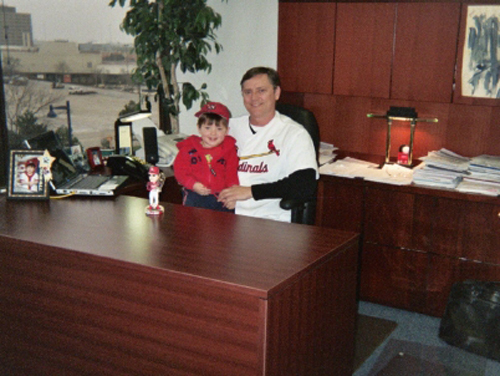Bringing It All Back Home
When the St. Louis Cardinals’ former stadium was demolished, fans rushed to pick up pieces from the ballpark where their memories were made. What they bought, and what it means to them.
Toward the conclusion of the 2005 baseball season, the St. Louis Cardinals sold off turnstiles, batting cages, photos of Hall of Famers, water fountains, TV sets, and nacho cheese tubs. Some items, such as slugger Albert Pujols’s locker, seemed destined to become collectors’ items, while others had practical applications—microwaves used by the food service staff, leather chairs from the luxury suites, and the grounds crew’s tractors.
In total, the Cardinals sold or auctioned off some 50,000 pieces of Busch Stadium, and on Nov. 7, 2005, a wrecking ball effectively ended the ballpark’s 39 years of service as the team’s home field. Five months later, a new Busch Stadium had been erected in its place, and was ready for the Cardinals and their fans—just in time for Opening Day 2006.
I spoke to several people who had purchased pieces of the old Busch and brought the items into their day-to-day lives. While people had different motivations for their purchases, the majority viewed their pieces of old Busch—a chunk of the outfield wall or a sign designating a particular section of seats—as a way to preserve memories that were a part of the old stadium.
A 21-foot-long section of the outfield wall hangs in the home of Jessica Barbieri and her family. The wall is emblazoned with the words “National League Champions,” and is peppered with scratches from outfielders’ cleats and dents from the impact of batted balls.
Baseball is a big deal in my family. Two of my great-aunts spent decades in local baseball. One was a treasurer of the St. Louis Browns and the other was secretary for [former Cardinals’ owner] Auggie Busch Jr. My grandfather was a general manager of a Detroit Tigers minor-league team.
When I heard that the Cardinals were going to sell things from Busch, I thought it was great because we were just planning to remodel our home. When I saw the wall, I knew it had to be in our basement.
There are six panels to the wall, and we hung it on a custom-built frame. It fits perfectly between the floor and the ceiling. We’ve complemented it with wood flooring and our collection of baseball memorabilia. The wall is a great centerpiece.
My husband and my daughter and I have been going to Cardinals games forever. To me, this wall symbolizes our family’s baseball history.
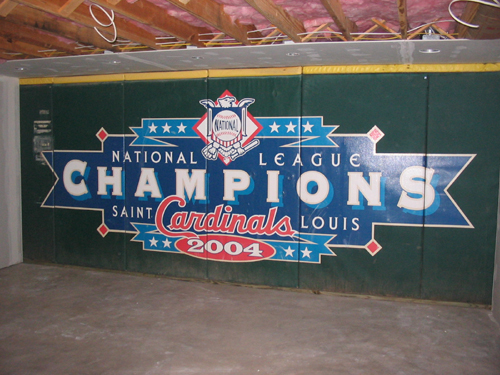
The large number five that indicated an entrance gate at the former Busch Stadium was purchased by Scott Risch, a real estate agent. Scott also purchased a flag that once flew over Busch Stadium, the wagon gate that was once part of the outfield wall, and a large banner featuring a panoramic photo of Busch Stadium packed with fans and a slogan, “Dad took you to your first game—you took him to the last game,” encouraging attendance during Busch’s final season.
The big no. 5 sign is sitting right now next to the fireplace in my living room. I need to figure out where, exactly, to put it.
This sign wouldn’t mean much to many people, but it means a lot to me.
There were many times my dad and I met at Gate 5. My mom would drive me down and we’d wait in the car, then Dad would meet me. We did this from the time I was seven years old until 14.
My father was an attorney for 54 years in St. Louis. We went to lots of games together. We went to double-headers, sometimes saw [Bob] Gibson pitch the first, [Steve] Carlton the second—with those guys throwing the games didn’t last long, and within a few hours my dad was back at his office and my mom would pick me up.
I was born in 1960. Busch opened in ’66. It was a special place. It was very sad, very upsetting when Busch was torn down. I have all sorts of great memories from the place.
One of the memories I really miss is baseball with my father. He was a huge baseball fan. He passed away a few years ago, in September 2000. He went to lots of the games with me, never caught a baseball when we were at a game together. Then, after I’d moved out of the house, he caught a ball. I’m not sure of the circumstances. But he loved it. He kept it on his dresser at home. I knew it meant a lot to him, so at his funeral I put the ball with him in his casket.
The next June, on Father’s Day, my son Clayton, he was about five at the time—well, I said to him, “You going to take your dad to a ball game?” He wanted to go, so we went. We were watching the game, enjoying the weather and the game. Then someone hit a foul ball. This thing came right my way, right to me. I’d never caught a baseball in my life. I didn’t think anything of it until that night, when I realized it was Father’s Day and that I hadn’t been at a game since my dad had died.
To me, and I know this doesn’t make sense, but it was like my dad was giving me back the ball that I’d given him at his funeral. Very eerie.
Now Busch is gone. It’s really something else. The place where all these memories took place is gone. Progress has to happen, I guess, but it’s sad. I think about how lucky people are who get to go to Yankee Stadium or Wrigley Field. They can go there and say, “That’s where I sat with my grandfather 30 years ago” or “We’re going to meet at Gate 5 because that’s where my dad and I met.” That’s gone.
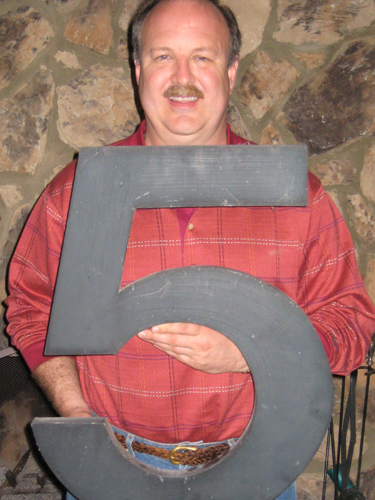
A sign from Section 266 was purchased by Travis Florey and Melissa Shultze, direct sales representatives for the St. Louis Cardinals in 2005.
Travis: We met in the Cardinals sales office in January ’05, on Mel’s first day. She’d torn her ACL during a skiing accident.
Melissa: I walked in on my crutches and there were four guys sitting, no chairs left. So I was standing, introducing myself. I had this huge brace on my leg because of the skiing accident. Travis was the only one to offer me his seat.
Travis: That season we got to know one another. We sat in Section 266. We went there all the time. When we heard about the auction we knew we wanted to get that sign.
Melissa: All of the sales staff gets season tickets, and we’re all in the same section. Travis and I sat next to one another all year long. There wasn’t a game on the day we got engaged. We were sitting around with eight different employees. We sat there every game together and it was important to us. It’s a piece of us, I guess.
Travis: Our wedding was in Busch, too. This is where we met, where we got engaged. It made perfect sense to us.
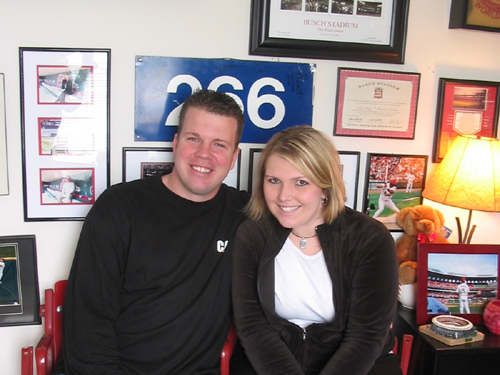
A “ghost panel” of Joe Medwick is in the office of St. Louis-area resident John George, the grandson of Joe Medwick, who played for the St. Louis Cardinals from 1932 to 1940 and 1947 to 1948, and was inducted into the Baseball Hall of Fame in 1968.
It’s glass and metal. The frame is stainless steel. It holds two frames of glass that hold a translucent photo of my grandfather in the middle of it.
There are certain mementos, gloves and bats and so forth, but there aren’t a lot of pictures like this one. I have a World Series photograph of him from ’34. Back in the ’30s and ’40s they didn’t make lots of photos or movie footage. Those photos don’t give the sense of his physical presence. There are very few things that are life-sized, and this one is actually bigger than life. I’m the same height as my grandfather, not quite five-foot-10, and this is more than seven feet tall, so it’s a little overwhelming.
We have to determine how and where to put the piece. It won’t fit through lots of doorways.
This is from the Stadium Club, one of the club restaurants in Busch. My grandfather was among the eight Hall of Famers in the room—Red Schoendienst, Stan Musial, Bob Gibson were some of the others. The panels essentially separated the Stadium Club in half.
It was an important memento to my family. We didn’t want it to land in a bar or someplace where they might not appreciate it. We were very happy to hear that we’d gotten it.
In the photo, he’s in uniform in a batting cage. From my research, it was taken in 1935. He’s swinging a bat; you can see the batting cage net. It’s from Sportsman’s Park.
My grandfather and I were very close. My parents divorced when I was young, and I wound up living quite a bit at my grandparents’ home. He was one of the team’s hitting instructors after retiring and there were times I wound up traveling with him after my baseball season was done. We went to Tulsa, where the Cards had a triple-A team, Johnson City. My grandfather worked with Keith Hernandez, he was his protégé. Bake McBride was there, all of the Cardinals minor leaguers.
He died in March ’75, during spring training. I was 13 when he passed away. He’d had a big impact on me.
I took my son to Cooperstown so he would get a sense of who his grandfather was. I was there in ’68, when my grandfather was inducted. My son was the same age I was when I saw my grandfather get inducted. That was a trigger for realizing his heritage. His middle name is Medwick.
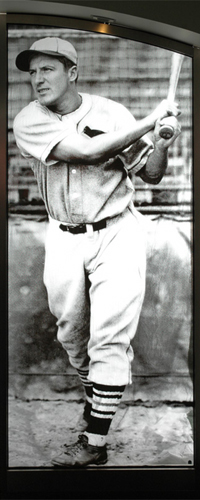
The former desk, chair, credenza, and telephone of St. Louis Cardinals manager Tony La Russa are in the office of Robert Cramer, and two items—a banner that flew above the former Busch Stadium, commemorating the Cardinals’ 1982 World Series title and a sign from the team’s former batting cage—are in his Chicago-area home.
I didn’t anticipate buying Tony La Russa’s desk. I couldn’t believe it when I actually won it, because the bidding kept going and going—it wasn’t until 11 or 12 at night when I found out I’d won. I did a dance around the living room to celebrate. No one was around.
I’ve got the desk at my office. It’s great. Sometimes I have to pinch myself that I’ve actually got it. I won’t think about it for a couple days and then it’ll hit me that I’m at La Russa’s desk. It’s really cool.
I always liked Tony La Russa as a manager, even when he was with the A’s and the White Sox. I sit in the chair, see the cleatmarks, imagine the conversations that took place over the desk. He gives me some inspiration. He’s the third-winningest manager in baseball history. When you have the chance to buy something like this, you’ve got to take advantage. It cost about $7,000. It’s more than I’d pay for an average desk, but I wasn’t just buying a piece of wood. I thought I’d always regret not getting it. Here at work people come in, like to talk about sports, and I let them sit at the desk. It’s something I’m going to be proud of.
I grew up in Bloomington-Normal, Ill., which is sort of the Mason-Dixon line dividing Cardinals and Cubs territory. My father was a lifelong Cardinals follower. I became a fan in the ’60s. The ’67 series is the first I remember. I was six years old, the Cardinals were in the World Series; that was my dad’s favorite team. How could they not have been my favorite team? It didn’t matter how many Cub fans were in the neighborhood. I was hooked.
I eventually moved to Chicago but those baseball habits don’t die. I’ve still got that little kid in me. Years ago, I saw several games at Comiskey back when La Russa managed the White Sox. He was more of a curiosity, a very young manager with long hair. He was younger than some of his players. Bill Veck [the former White Sox owner] really liked him. I’m a big Tony La Russa fan. I watched him as a rookie manager with the White Sox, a long-haired guy. He didn’t have the reputation then that he has now. My dream came true in ’96 when he came to the Cardinals.
If you’re picking one person whose desk I’d own, I’d say there’s Tony La Russa and Donald Trump. La Russa is the epitome of managers, that’s what I do as a mortgage manager. Every game he makes strategic moves, considers how players are doing. When he gets second-guessed you don’t always know what he’s considering, going through. Anyone who runs their own business can relate to that. We have to deal with personalities, day-to-day developments. A manager in baseball has to run the gamut of experiences.
I like La Russa’s attitude, how he doesn’t quit, is always thinking about how to get the upper hand, help the team win. He doesn’t showboat or get into shouting matches. He gets the respect of the players and coaches by being prepared for what he has to be doing.
I also was the high bidder on a sign that hangs in the batting cage, saying not to bring in sunflower seeds—I want to hang it in my bathroom—and a 10-foot-long banner that flew in the upper deck in the outfield, commemorating the 1982 World Series win. It’s the series I went to. The ones in the ’60s I watched on TV. In ’82 my buddies and I scrounged up our life savings. I think we were broke for two years after that.
The banner is hanging in my house. I wanted to put it in the living room. My wife’s a big baseball fan, too. So I asked her about hanging it in the living room and she said, “No.” It’s in my upstairs office. It covers one wall very nicely.
My dad died back in ’97. He’d get a big kick out of all this. I’d bring him to my office and he’d sit in La Russa’s chair, kick his feet up on the desk. He’d really like it.
I named my son Brock after [Cardinals Hall of Famer] Lou Brock. We go down to St. Louis a couple times a year for the weekend and to see some games. I’ve made the trips more the past two years—four, five, six times since the team has been in the playoffs. I take my son to the ballgame, always find someone in the stands who takes our picture for us.
I’ve seen so many games over the years. I went to my first in ’69, Brock, Dickie Allen, Bob Gibson were on the team. I’ve been to hundreds since. I took my son and we sat in the same seats I sat in with my dad. That was a great thing to do.
The last game I saw at the old Busch was the last game there, game six of the [2005] NLCS. It was bittersweet. It was like having the house you grew up in torn down. Even if you don’t live there any more, you have several memories. I think everybody hates to watch it go because so many people have special memories of the place with family and friends.
People were crying during the last game, they were sitting there after it ended, didn’t want to leave. An hour after, security guards started telling people they had to leave. I think it was a special place. I didn’t cry though.
Concerning Tony La Russa’s March 22 DUI arrest:
I was at the Cardinals’ spring training game the next day when I found out about his D.U.I. I couldn’t figure out why all of the fans were standing up and cheering when La Russa came onto the field but that’s a reflection of who he is. He’s not a guy who goes out and gets D.U.I.s. He’s responsible and he made a mistake. Fortunately no one was hurt.
From my perspective as a fan, if he had tried to make excuses and run away from the situation, I’d have been disappointed. He manned up and apologized. It’s something that could happen to anyone in sports. It doesn’t change my opinion of him as a manager or sports person.
I was amazed because he’s always been exemplary on and off the field. He’s conducted himself in the highest manner. I’d bet $1 million that will never happen again with him.
